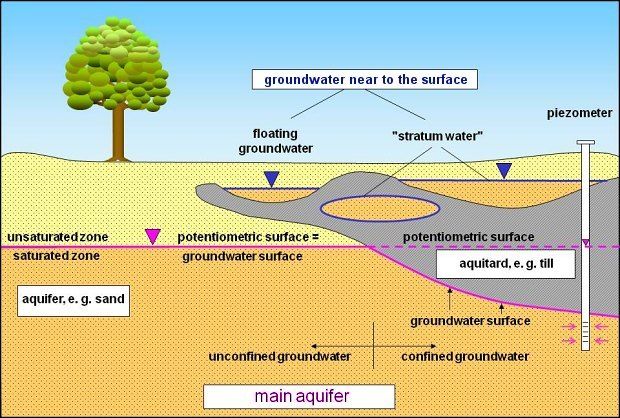Exact knowledge of the current groundwater levels, and hence also of groundwater stocks, is imperative for the State of Berlin, since all the water for the public water supply of Berlin (215 million cu.m. in 2015) is obtained from groundwater. This groundwater is pumped at nine waterworks, almost entirely within the territory of the city. Only the Stolpe Waterworks on the northern outskirts obtains water from Brandenburg, but also supplies Berlin with approx. 9 % of the city’s total intake (Fig. 1).
Groundwater Levels of the Main Aquifer and Panke Valley Aquifer 2016

Fig. 1: Location of the nine waterworks which supply Berlin with drinking water, as of May 2016
Image: Umweltatlas Berlin

Fig. 2: Phenomenology of Underground Water
Image: from Hölting 1996

Fig. 3: Hydrogeological Terms
Image: Umweltatlas Berlin

Fig. 4a: Groundwater infiltrates into bodies of water
Image: Umweltatlas Berlin

Fig. 4b: Bank-filtered water caused by flooding: Surface water infiltrates into the groundwater
Image: Umweltatlas Berlin

Fig. 4c: Bank-filtered water caused by discharge of groundwater: due to the drop in the groundwater caused by wells, surface water infiltrates into the groundwater
Image: Umweltatlas Berlin

Fig. 5: Morphological Outline Map of Berlin
Image: Umweltatlas Berlin

Fig. 6: Geological Outline Map of Berlin
Image: Umweltatlas Berlin

Fig. 7: Schematic hydrogeological cross-section of Berlin, from south to north
Image: from Limberg, 2013

Fig. 8: The unconfined Panke Valley Aquifer (Aquifer 1) in the north-western area of the Barnim Plateau is situated above the Main Aquifer (Aquifer 2), which is confined in this area
Image: Umweltatlas Berlin
